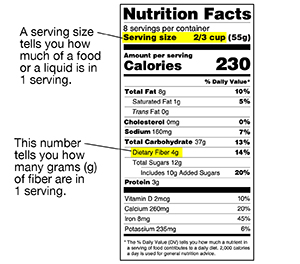A
B
C
D
E
F
G
H
I
J
K
L
M
N
O
P
Q
R
S
T
U
V
W
X
Y
Z
Topic IndexLibrary Index
Click a letter to see a list of conditions beginning with that letter.
Click 'Topic Index' to return to the index for the current topic.
Click 'Library Index' to return to the listing of all topics.
Discharge Instructions: Eating a High-Fiber Diet
Your healthcare provider has prescribed a high-fiber diet for you. Fiber is what gives strength and structure to plants. Most grains, beans, vegetables, and fruits contain fiber. Foods rich in fiber are often low in calories and fat, but they fill you up more. These foods may also reduce the risk of certain health problems.
There are 2 types of fiber:
-
Insoluble fiber. This is found in whole grains, cereals, and certain fruits and vegetables (such as apple skins, corn, and beans). Insoluble fiber is made up mainly of plant cell walls. It may prevent constipation and reduce the risk of certain types of cancer.
-
Soluble fiber. This type of fiber is found in oats, beans, nuts, and certain fruits and vegetables (such as strawberries and peas). Soluble fiber turns to gel in the digestive system, slowing the movement of the digestive tract. It helps control blood sugar levels and can reduce cholesterol, which may help lower the risk of heart disease. Soluble fiber can also help control appetite.
Home care

-
Know how much fiber you need a day. The recommended daily amount of fiber is 25 grams for women and 38 grams for men. After age 50, daily fiber needs drop to 21 grams for women and 30 grams for men.
-
Start by slowly adding high fiber foods into your diet over the course of a week or two if you haven't been eating a lot of fiber. This will help your body adjust. It will help prevent digestive problems that can occur if you add too much fiber to your diet all at once.
-
Drink plenty of fluids as you increase the fiber in your diet. This will help prevent constipation.
-
Ask your healthcare provider about a fiber supplement. Always take fiber supplements with a large glass of water.
-
Keep track of how much fiber you eat.
-
Eat a variety of foods high in fiber.
-
Learn to read and understand food labels.
-
Ask your healthcare provider how much water you should be drinking.
-
Look for these high-fiber foods:
Follow-up
Make a follow-up appointment, or as advised. Ask your healthcare provider if seeing a registered dietitian may help you plan a high-fiber diet.
Online Medical Reviewer:
Brittany Poulson MDA RDN CD CDE
Online Medical Reviewer:
Diane Horowitz MD
Online Medical Reviewer:
Heather M Trevino BSN RNC
Date Last Reviewed:
12/1/2022
© 2000-2025 The StayWell Company, LLC. All rights reserved. This information is not intended as a substitute for professional medical care. Always follow your healthcare professional's instructions.